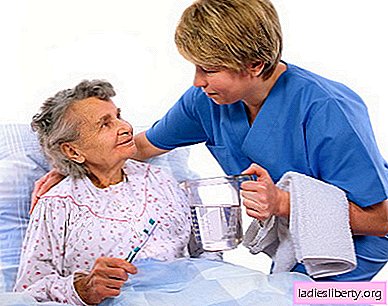
Pressure sores - necrosis (or necrosis) of soft tissues, which occurs as a result of excessive pressure and is accompanied by impaired blood supply and nervous trophism at the site of damage to the soft tissues.
There are several degrees of development of pressure sores. The first degree is characterized by persistent hyperemia, which does not pass after the cessation of pressure. With the II degree, a shallow skin disorder is observed, which extends to the subcutaneous tissue. If the III degree of bedsores develops, the skin is destroyed up to the muscle tissue, while the affected area looks like a wound. IV degree is characterized by extensive damage to the soft tissues and bone.
Pressure ulcers - causes
Pressure ulcers in bedridden patients arise as a result of displacement of the upper layers of soft tissues. This is usually the result of improper care. For example, when changing a vessel or when changing bedding, a patient is pulled over the bed. Also, bedsores develop if the patient does not sit properly, gradually moving out of bed.
Pressure sores do not occur in all bedridden patients. There are a number of factors:
- lack or excess weight;
- lack of fluid or improper nutrition;
- increased sweating (especially at high temperature);
- incontinence of feces and urine;
- non-compliance with hygiene standards;
- linen with rigid seams or folds;
- various allergic reactions;
- smoking abuse;
- diseases that are accompanied by damage to the vessels of the skin (diabetes, cardiovascular disease).
Pressure ulcers - symptoms
Pressure ulcers occur at the points of contact of the body with the surface on which the patient lies - buttocks, lower back, sacrum, elbows and heels, shoulder blades, occipital region.
The disease begins to manifest as redness and swelling of the skin in those parts of the body that have been subjected to prolonged pressure. Subsequently, the skin begins to be rejected, becoming red or pink. A pinkish liquid begins to protrude on the affected surface. In case of prolonged absence of treatment, bedsores can form non-healing ulcers.
Pressure ulcers - diagnosis
To make an accurate diagnosis, the doctor sets the symptoms of the disease, performs an examination of the patient. If necessary, the following tests can be assigned:
- checking for bacteria in the wound;
- a blood test to establish the presence of an inflammatory process in the body;
- bone scan or x-ray (if there is a suspicion of infection of bone tissue).
Pressure ulcers - treatment and prevention
The treatment of pressure sores is aimed at reducing the damaging factors, as well as directly to the treatment of wounds. In addition, it is necessary to ensure the proper level of patient care.
Treatment consists of the following steps:
1. The correct position of the patient’s body. Requires a change in body position (at least every 2 hours), the use of special linen and mattresses.
2. Hygiene measures. Regular cleansing of contaminated skin with warm water and soap or a tool recommended by the attending physician is necessary.
3. Wound treatment.
4. Proper nutrition. Doctors recommend mineral supplements and vitamins.
5. Surgery of the affected areas. In some cases, it is necessary to remove infected tissue, as well as a skin transplant. III and IV degrees require mandatory surgical intervention.
A special place is the prevention of pressure sores. Before the onset of the first symptoms of the disease, it is necessary to properly care for the bedridden patient: cleaning the skin, using special pads, mattresses, and linen. It is also necessary to try to monitor compliance with the correct position of the patient's body.











